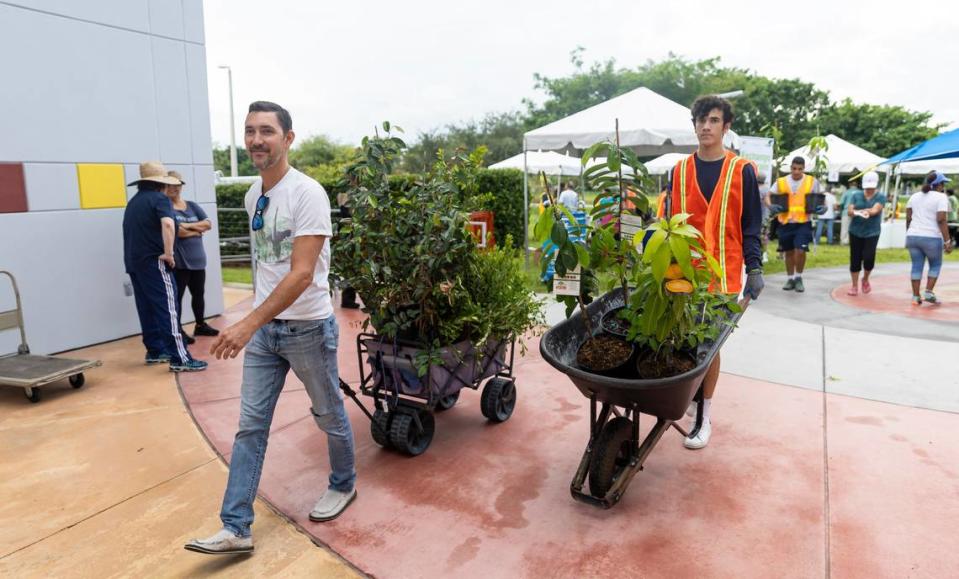Miami-Dade has fallen behind on its decade-old pledge to cover more than 30% of the county with tree canopy, leading to growing inequality across the region as wealthier neighborhoods stay shaded, while poorer communities bake — leading to higher electric bills and more emergency room visits.
These issues, outlined in a Miami Herald investigation published earlier this year, spurred commissioners to ask Mayor Daniella Levine Cava’s office to come up with a plan to keep the county green.
On Friday, the county released its draft Urban Forestry Plan, which calls for developing community partnerships, a stricter maintenance schedule and chasing more grants.
“We needed to regroup and figure out how we get to that goal,” said Jane Gilbert, the county’s first heat officer, who drafted the plan. “We want to make sure that residents, businesses, and stakeholders all benefit from what trees provide and work together to maintain them.”
READ MORE: Miami-Dade County’s urban tree project unable to shade residents from record heat
To meet their goal, the plan is clear that the county needs “all hands on deck.” Only 12 percent of land that can be developed on is owned by the county, which county officials say limits control over where trees can go.
The county plans to continue to work with school districts and faith-based groups that own large swaths of land, hire professional arborists to properly prune county trees, and start an ambassador program to educate the community on why trees are good for neighborhoods.

Trees can’t just be planted, they need to be grown
After “aggressive county action” the tree canopy coverage increased from 12 to 20 percent since the county set its 2006 goal of 30% coverage by 2030, Gilbert said, but since 2016 the growth has gone flat.
While planting more trees will be necessary to meet their goal, Gilbert said it is critical to maintain the trees already in the ground because those will be the first to mature and offer more shade.
The Herald investigation also drew attention to the lack of maintenance that led to trees dying in the county and that behind the scenes, there is no uniform data that can be used to measure all planting efforts. More than 17 years and millions of dollars later, the investigation revealed the county is not even close to reaching its goal.
One big lesson the county learned is trees need the same amount of upkeep as roads and buildings. Trees less than five years old are extremely vulnerable to the elements and weed whacking on the streets. Even one storm could end a small sapling’s life.
75° F
140° F
Coral Gables




Hialeah




The county said it prioritizes neighborhoods with sparse tree coverage and wants to plant trees where people wait around in the sun, like at bus stops.
Right now, the county doesn’t have the staff to keep up with maintenance in parks, streets and in environmentally protected land, which is typically wild forest. The county wants to look into other areas to add to the officially protected land list, which would protect more land from development.
Recently, the Broward County Commission adopted an ordinance regulating the tree trimming industry and requiring all businesses or municipalities that trim trees to obtain a Broward County Tree Trimmer License to do the job. Pruning trees keeps them healthy, but if too much is cut the tree won’t provide shade and is exposed to wood-eating insects.
Miami-Dade County said it is looking into Broward’s tree trimming ordinance and wants to recruit professional arborists to set a standard for best pruning and trimming practices, as well as act as ambassadors to get homeowners on board with preserving and planting trees.
For some people, the upkeep of trees can be a hassle. If not cut back, the trees might press up against a fence or cause concrete to buckle. But, with some upkeep, trees don’t only offer a much-needed reprieve from the heat, but also clean stormwater runoff and suck up pollution.
Some invasive trees that are not strong enough to handle Miami’s tropical climate will also have to be removed. An example of this is the ficus tree, the official tree of Bangkok, which caused power outages earlier than expected in a 2016 hurricane. The county wants to provide woodworking classes and allow people to pick up and give the wood a new life.
The county is also considering climate change in selecting what trees to plant because they’re seeing a shift in species that are successful in South Florida’s tropical climate.
“We want to be forward-thinking about what species we select to prioritize for the future,” Gilbert said.
READ MORE: What to do if your Miami-Dade neighborhood needs more trees
There are a variety of grants, including a $10 million reward given by the U.S. Forest Service to plant trees over the next five years, but totaled together the county will need more funding to reach its goal of planting 300,000 trees when now also factoring in the upkeep.
The county plans to finalize the draft tree canopy plan by November after public workshops to get community input. The next one is virtual on Thursday, July 25 and if you can’t make that one there’s an in-person option at the Stephen P. Clark Government Center on Aug. 1. They are also accepting online feedback.
Ashley Miznazi is a climate change reporter for the Miami Herald funded by the Lynn and Louis Wolfson II Family Foundation in partnership with Journalism Funding Partners.
Source Agencies



